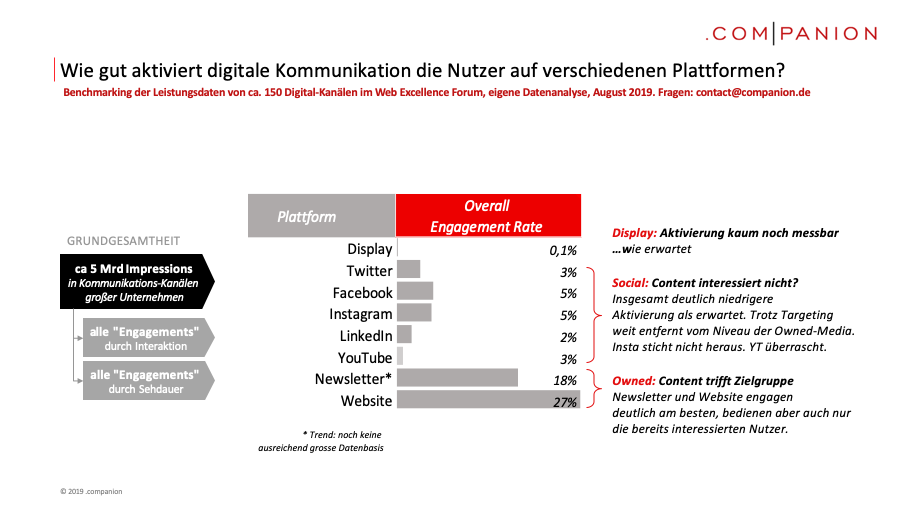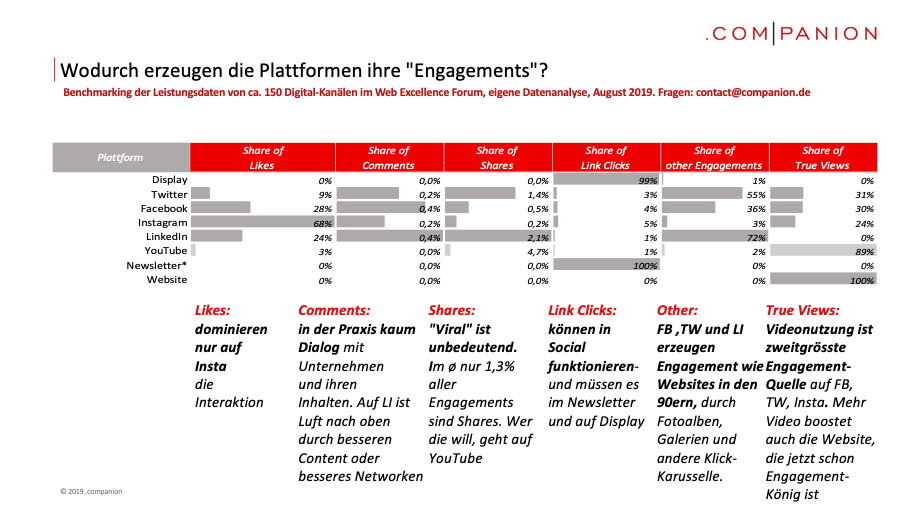Digital excellence has many facets. One of them is the question of how good the content is that communications and marketing departments play out and promote via platforms on the web and social. The quality of a published content piece is usually measured by the so-called "engagements. We have analyzed how "engagements" behave in a comparison of platforms and which platforms generate them and how. HERE you can find the results - practical handouts for editors, creatives and planners. #Excellence #IntegratedCommunication #Controlling
What actually is engagement?
First of all: "Engagement" is pronounced in English ("Ingäitschment") and not in French (Ongaschmon). This note is unfortunately necessary. Because all too many media professionals, journalists and (other) activists on their own mission, misunderstand "clicks in social" as social engagement. Engagements are not engagements, they are only ingäitschments.
By (English pronounced) engagements are meant those keyboard, mouse, and voice interactions that are User readers to perform with a digitally published content piece. Shares, Likes, Comments, etc. - with this Purely click-based definition of engagement all social media evangelists and performance marketers are usually satisfied. But not advertising communicators.
Communications professionals know that the most powerful form of content delivery is passive media use without interaction: you watch a movie and you're impressed, without any popcorn popping or clicking.
Since this click-free hypothesis on the impact of communication has been well proven for about 100 years, it is quite imperative that "true views" count as engagement in addition to interactions. These "true views" are a viewing time-based currency for content engagement that first Google (YouTube) and then we used. A true view engagement occurs when a piece of content is viewed for at least 30 sec. Google has announced that it will drop this "true view", which still includes a whole rat race of special case distinctions. We won't do that, because the currency has proven itself. Not only for video content, but also for website content.
How to compare engagements?
Quite simply, you count the interactions on the one hand, exactly as they are delivered by the platforms' dashboards - anything else is not practical at this point, as the platforms subject their "analytics black boxes" to permanent and non-transparent changes. And you count on the other hand the True Views that lasted 30 sec or shorter (for short video runtimes).
1 interaction plus 1 "True View" equals 2 engagements. This rule applies in our Content.ONE dashboard service for every digital platform, really.
What have we analyzed?
For our Web Excellence Forum, a benchmarking circle for digital excellence that already won an award in 2008, we continuously compare the media performance of about 150 web and social channels via our Content.ONE system.
We've now simply taken 5 billion impressions (pages, posts, videos) and looked at how the engagements are distributed and what generates them.
Our sample does not claim to be representative. It is the data that we have evaluated, nothing more.
The data relates to digital communication (image impact) and not to performance marketing (sales impact) . Click-outs (from advertising materials) and click-ins (to website target actions) are therefore definitely underrepresented. Nevertheless, we assume that those responsible for content marketing will find a great deal of their own practical experience reflected in the results. The basic population should be large enough.
And what is the result?
Here you go.

